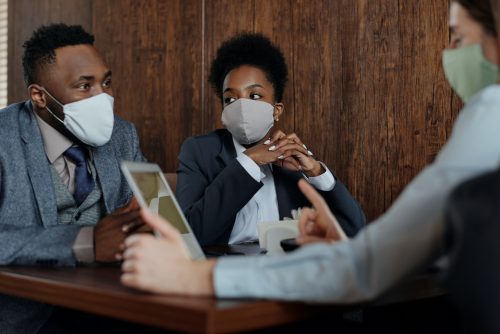Guidance and restrictions relating to safety during the coronavirus pandemic changes on a regular basis, but one thing is consistent and clear: you should only leave your house for essential purposes. No one wants to put themselves at risk unnecessarily, but the business world can’t stop entirely, so lots of people are still finding themselves having to travel for work.

Of course, those traveling for essential business should follow whatever the current government guidance is for the area within which they’re moving around, but there are additional measures that can be taken to best protect against the risk of contamination with Covid-19 (or any other illness!).
Get tested!
A test is available on the NHS for anyone displaying one or more of the main symptoms of Covid-19; a new, continuous cough, a fever, or a loss or difference to the sense of taste or smell. However, if you’re traveling regularly or find yourself spending more time around other people than you would like, it is possible to take a self-administered test using Medicspot home testing kits and give yourself peace of mind that you’re not carrying (and therefore potentially spreading) the virus.
Self-swab tests are completed by an individual on themselves without the need for the involvement of medical staff. This avoids any further risk of viral spread and allows for individual autonomy over what can be considered invasive testing. These tests are then analyzed and reviewed by a private clinic who usually delivers the results within 24-48 hours. The accuracy of self-swab home tests is the same as those done by a healthcare professional if completed correctly.
Keep your space
The term ‘social distancing’ only really entered the public lexicon last year, but it’s quickly caught on and you should by now know what it means! When using public transport, it’s not always easy to keep your distance, but if at all possible, try and stay 2 meters or further away from other people. Some modes of transport such as buses and trains should have lowered available seats and cordoned-off set areas for travelers. But, if not, just use your common sense. The bigger the distance you can keep, the better – particularly in confined spaces. If you’re really not able to stand or sit away from people, do what you can to aid ventilation: open a window and allow as much air to pass through as possible.
Mask up
The guidance around the requirement of wearing a face covering is updated regularly, but generally speaking, the more you can wear one, the better. Studies show that face masks are able to prevent the transmission of the virus through respiratory droplets, even in close-contact settings. If you’re on your own in a car or vehicle you don’t need to wear one (unless, of course, it makes you feel better to), but when around other people both indoors and out, it’s always best to mask up.
There are medical exemptions to wearing masks but in most circumstances, an alternative face covering can be used. Other types of PPE may not be as effective as a simple nose-and-mouth face mask but can help offer a degree of protection that wearing nothing would not provide.
If your travels take you abroad, understanding the specific entry requirements and safety protocols for your destination is crucial; find out more at Easytouristcard, where you can get detailed guidance on the necessary preparations to ensure a smooth and safe journey.
It can certainly be quite daunting to travel in times like these, but if you take all necessary precautions and exercise a little common sense, there’s no reason it can’t be done safely. Do whatever you need to feel safe and don’t be afraid to allow a little extra time to get around as a result. Until life resumes to ‘normal’, do what you can with the circumstances you’re in.
Interesting Related Article: “5 Business Travel Trends to Watch For in 2021“

